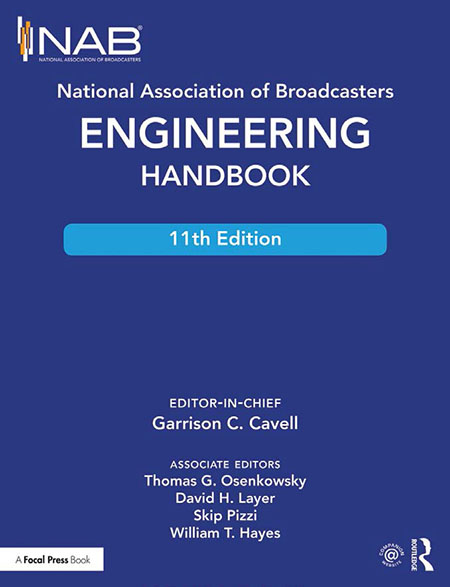NAB Updates Engineering Handbook
ALEXANDRIA, VA.—The latest in a long line of broadcast engineering reference books from the National Association of Broadcasters is now shipping—the 11th edition of their NAB Engineering Handbook. The appearance of each of these volumes is something of a signal occasion, as they aren’t exactly published on a regular basis. (The first Engineering Handbook appeared in 1935, and the 10th was issued more than a decade ago in mid-2007; only 11 books in 82 years.) These encyclopedic reference works have been welcomed by several generations of broadcast engineers, due to the amount of new and timely information appearing in each.
The 11th edition is no exception, with 99 chapters spread across 1,947 pages covering virtually all aspects of broadcast engineering, and reflecting the many developments and changes that have occurred since issuance of the last Handbook. Obviously, it’s impossible to provide a complete description of everything in the new volume in the limited amount of review space available, but I’ll try to hit the highlights.

RADIO-TV COMMONALITIES
The new Handbook straddles both radio and television engineering communities, with coverage of such common areas as the electromagnetic spectrum, frequency coordination, regulatory matters, facility documentation, emergency alerting; project management, satellite technology, fiber-optics, signal coverage, safety considerations/practices, broadcast towers, lightning protection, studio noise control, automation, microphones, signal compression, STLs, transmission lines, measurement techniques, grounding, electrical power systems, and disaster planning—just to name a few.
In addition, the Handbook includes more than 700 pages of television-specific information, spanning such areas as digital video standards and practices, cameras/camera support, graphics, recording, intercom/IFB technology, loudness, video format/standards conversion, video contribution/distribution, ENG/EFP, weather radar, asset management, facility planning, lighting, workflows, transmitters, antennas, SFNs, closed captioning and more.
Mirroring some of the many industry changes since the 10th Handbook was published, readers will note inclusion of very comprehensive information about ATSC encoding, transport and PSIP, while the chapter on “Film for Television” in the previous edition has been omitted. The facility design chapter reflects the move away from CRT monitors to flat screens since the last Handbook appeared. A decade ago, many of us were still getting up to speed with HDTV; now there’s a complete chapter on UHD. Another added chapter is “Next-Generation DTV Systems,” which provides a “deep dive” into the two digital television transmission systems (ATSC and DVB) that have almost totally replaced analog TV broadcasting during the past decade.
Curiously, while the new book does include a chapter on streaming of radio content via the internet, there is not television counterpart covering IP transport of video.
‘BEST & BRIGHTEST’ MINDS
Such a comprehensive reference work as this could never have been produced by one individual. Its editor-in-chief, Gary Cavell, and associate editors Tom Osenkowsky, David Layer, Skip Pizzi and Bill Hayes, have tapped some of the best and brightest minds in the business to prepare chapters and sections that reflect their particular areas of expertise and experience. The list of authors who contributed to the new Handbook numbers more than 125, with many familiar names in the field of broadcast engineering appearing.
Get the TV Tech Newsletter
The professional video industry's #1 source for news, trends and product and tech information. Sign up below.
In planning the 11th edition, Cavell and his associate editors wanted to make sure that the book would be a “practical” engineering reference source, rather than something resembling a college textbook for an advanced course, and after examining this new edition you’ll see that they’ve achieved their goal. This book won’t sit on your bookshelf or desk taking up space; you’ll find yourself referring to it on a very regular basis. My only (and admittedly slight) issues with this new Handbook are the absence of color illustrations and the small size of some (admittedly a minority) of the artwork that’s included. The use of color would definitely have enhanced “readability” of some of the charts and photos. However, even in the 21st century, color printing is considerably more expensive than black-and-white, and would have proportionally increased the price tag. And while the size of the overwhelming majority of illustrations is very adequate, there are some cases where a hand magnifier is going to be needed unless you have some very extraordinary eyes.
The 11th edition of the NAB Engineering Handbook is available from the NAB’s online store (www.nabstore.com), as well at Amazon, barnesandnoble.com, and other online booksellers. The list price is $220, but at the time of this review, the NAB store was offering the volume at a special sale price of $187. E-book editions are available (Barnes and Noble offers a Nook Book version for $192.99, and Amazon has priced their Kindle edition at $176.
Regardless of which format you prefer, this is a very rich source of reference in virtually all areas of broadcast engineering and should be part of the library of anyone who is serious about the engineering side of the profession.
(As a matter of disclosure, the reviewer contributed a chapter on shortwave radio to the new handbook.)
James E. O’Neal is a retired broadcast engineer and the former Technology Editor of TV Technology magazine. He contributes to that publication and Radio World on a regular basis.
